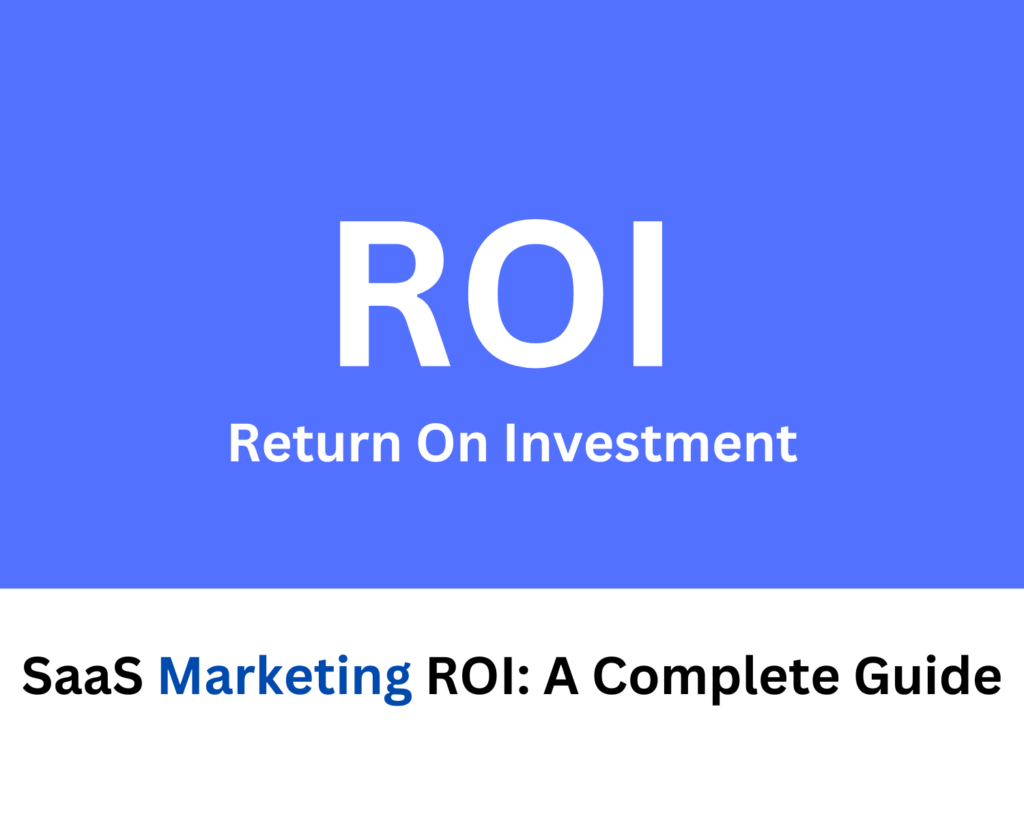For the past ten years or so, it was like a golden age for tech. Lots of people were investing money in tech startups. This made the tech industry really popular because it had lots of high-paying jobs and the value of stocks was going up.
But now, things have changed. Some SaaS companies, don’t have as much money as they used to. They’ve had to let go of some employees, change how their teams work, and even get rid of some parts of the company.
And guess what? Marketing is one of the things that these SaaS companies are cutting back on. They’re trying to spend less money on marketing so they can save money and make more profit.
This puts a lot of pressure on SaaS marketing teams. They have to figure out how to make their marketing efforts work with less money.
In this article, we’ll talk about how to measure something called SaaS marketing ROI. That’s a fancy way of saying we’ll figure out if the money spent on marketing is making more money for the company. We’ll also share some tips on how to make the most of your marketing budget.
What is SaaS Marketing ROI?
Alright, let’s dive into understanding marketing ROI from a fresh perspective.
Marketing ROI, or return on investment, is essentially about figuring out how much bang you’re getting for your buck when it comes to your marketing spending. It’s like asking, “Hey, for every dollar I put into marketing, how much am I getting back?”
You might have heard it called by other names like MROI or ROMI, which all boil down to the same thing.
Here’s the basic math behind it: You take your sales revenue and subtract your marketing costs. Then you divide that by your marketing costs.
Formula: (Sales revenue – Marketing cost) / Marketing cost
For instance, let’s say you spent €100,000 on marketing for the year, and that brought in €1,000,000 in sales.
Your ROI would be (1,000,000 – 100,000) / 100,000 = 9.
So, for every euro you spent on marketing, you got back €9 in sales. Sounds simple, right? Well, not quite.
Here’s where things get tricky. This straightforward formula might give you a rosy picture, but it doesn’t always tell the whole story.
How can you be sure that the sales you’re seeing are directly because of your marketing efforts? What if those sales would have happened anyway, even if you didn’t spend anything on marketing?
That’s where the real challenge lies: figuring out how to measure ROI accurately. It’s not as easy as it seems, but don’t worry, we’re about to unravel this mystery together.
How to measure SaaS Marketing ROI?
To determine marketing costs for SaaS businesses, you need to consider both direct and indirect expenses. Direct costs include items like paid advertising, content creation, marketing software, agency fees, and promotional campaigns. These costs are directly associated with marketing activities and should be tracked and recorded.
Indirect costs are the expenses that indirectly contribute to marketing efforts. They can include salaries, benefits, office space, utilities, and other operational expenses related to the marketing team. Allocating these costs accurately involves determining the portion that can be attributed to marketing activities, which can be done using various cost allocation methods like percentage-based allocation or activity-based costing.
You should also account for staff and technology investments. This includes considering the salaries, bonuses, or commissions of marketing team members involved in campaigns, as well as investments in marketing automation platforms, CRM systems, analytics tools, and website hosting.
SaaS Marketing ROI: Measuring Different Channels
Up until now, we’ve been discussing marketing ROI in a broad sense, looking at the big picture across the entire company.
Every marketing team, big or small, needs to roll up their sleeves and dig into the details of individual campaigns.
Think of it like zooming in from a panoramic view to street-level exploration. We’re going to break down the specific metrics for different marketing channels and brainstorm some savvy strategies to amp up our ROI.
PPC Ads
When it comes to paid advertisements, we shift gears and talk about RoAS (Return on Ad Spend) instead of ROI. Here, the investment is the money you splash out on ads, essentially mirroring the same concept.
Let’s break it down with an example: Say you made a profit of $15,000 from a PPC campaign that set you back $3,000. Your RoAS calculation would look like this:
[($15,000 – $3,000) ÷ $3,000] x 100 = 400%
SEO
Calculating ROI for SEO requires an extra step compared to other methods because we need to measure the profit directly linked to our SEO efforts.
Let’s say your SEO endeavors brought in an extra 150,000 website visitors. Now, how do we figure out the benefit of these additional visitors?
First things first, dive into your Google Analytics data. Find out your SaaS product’s average conversion rate and multiply it by the number of new visitors.
Imagine your SaaS company boasts a solid conversion rate of 2% (0.02). Your SEO efforts would’ve generated 3,000 new customers (0.02 x 150,000).
Next, multiply those 3,000 customers by your annual gross margin per customer. Let’s say that’s $150 this time. That gives you a profit of $450,000 ($150 x 3,000).
Now, let’s crunch the numbers for ROI. Suppose you invested $15,000 in SEO. Here’s the formula:
[($450,000 – $15,000) ÷ $15,000] x 100 = 2900% ROI.
That’s the kind of return that’ll make your efforts worthwhile!
Email Marketing
If there’s one golden nugget every growth marketer holds dear, it’s the knowledge that email marketing brings in a whopping $60 for every dollar spent. But if you’re still in the dark about your email marketing ROI, fear not! Today, we’ll shed some light on it.
Calculating ROI for email is a breeze. Most of the time, you’ll have a clear picture of how much you’ve invested in your SaaS email marketing endeavors. Plus, you can easily track customer data acquired through emails using tools like Google Analytics or your email marketing software.
For instance, let’s say you’ve managed to acquire 600 new customers through email, each contributing $70,000 in profit annually. Over the year, you’ve spent $20,000 on email campaigns. Here’s how your ROI stacks up:
[($70,000 – $20,000) ÷ $20,000] x 100 = 250% ROI.
Now that’s some serious return on investment!
Content Marketing
When it comes to content marketing campaigns, there’s a multitude of objectives to chase. But for SaaS companies, one goal stands out: educating the audience about their product.
The content serves not only to attract fresh faces but also to enlighten existing customers about the product’s ins and outs, like shedding light on alternative use cases.
But let’s talk about the tricky part—content-attributed ROI. Pinning down the exact contribution of your content in snagging leads is like finding a needle in a haystack. But don’t despair just yet! Your efforts will eventually reflect in other important metrics, such as Customer Lifetime Value.
Now, let’s shift gears to SEO content. Here’s where things get interesting—you can still measure ROI directly by keeping a close eye on the uptick in visitor numbers and conversion rates.
Social Media
When it comes to social media marketing, the primary goals often revolve around brand building, audience engagement, and fostering relationships. These aspects are more qualitative in nature, making them a bit tricky to measure in black and white terms.
The impact of your social media efforts tends to manifest in other critical metrics that drive SaaS growth. For instance, a successful campaign may lead to a noticeable uptick in your monthly and annual recurring revenue, reflecting the boost in brand awareness.
But here’s where things get interesting: There’s an exception to this rule. If you’re running paid ads linked to your landing page, you’ve got a direct pathway to calculating the ROI of your social media marketing efforts. Simply track metrics like click-through rates (CTR) and conversion rates, much like you would for regular paid ads. It’s a game-changer!
Why Calculating SaaS Marketing ROI Matters:
1. Measuring the Value: The computation of ROI empowers you to ascertain the value engendered by your marketing endeavors vis-à-vis the costs incurred. It offers a lucid depiction of how your investments translate into tangible results, such as sales, sign-ups, or other desired outcomes.
2. Resource Allocation: By identifying the marketing channels and tactics that yield the highest ROI, you can judiciously allocate your resources. This ensures that your budget is invested in strategies that yield optimal returns, ultimately enhancing your marketing performance.
3. Aligning with Business Goals: The calculation of SaaS Marketing ROI facilitates alignment between your marketing activities and overall business objectives. It enables you to focus on initiatives that directly contribute to revenue generation, customer acquisition, and long-term growth.
Together, these aspects underscore the significance of SaaS Marketing ROI calculation in driving success and propelling your business forward.
Key Challenges
Calculating SaaS marketing ROI poses several challenges, including:
1. Complexity of Impact Measurement: Measuring the precise impact of marketing efforts on overall ROI is intricate. With the multitude of channels and tactics involved in SaaS marketing, attributing the success or failure of specific campaigns to the resulting ROI becomes challenging. It requires navigating the interconnected nature of customer journeys and considering the long-term effects of branding and awareness initiatives.
2. Attribution and Tracking Issues: Determining which marketing activities directly contribute to conversions and revenue can be a hurdle. Customers interact with multiple touchpoints along their journey, making it difficult to attribute specific outcomes to individual marketing efforts accurately. Tracking mechanisms and advanced attribution models are needed to gain more insights into the impact of each campaign.
3. Data Limitations: Limited availability and quality of data can impede accurate ROI calculations. Incomplete or inaccurate data, data silos, and challenges in data integration hinder the effectiveness of analysis. Investing in robust analytics tools and ensuring data accuracy and completeness are crucial to overcoming this challenge.
Addressing these challenges requires a comprehensive understanding of the complexities involved in SaaS marketing, implementing advanced tracking and attribution models, and ensuring reliable and integrated data sources. By overcoming these obstacles, marketers can gain better insights into the effectiveness of their strategies and make informed decisions to optimize their ROI.
Laying the Groundwork for Calculating ROI: A Multifaceted Endeavor
Crafting the groundwork for ROI calculation in SaaS marketing entails a series of pivotal steps. One salient facet involves establishing unequivocal ambitions and aspirations. This course of action aids in delineating your intentions regarding the achievements sought through your marketing endeavors, thereby paving the way for effective ROI calculation. Herein lie the principal constituents to mull over when establishing goals and objectives:
Establishing Clear Goals and Objectives
Herein lie the principal constituents to mull over when establishing goals and objectives:
1. Specifying Measurable Objectives: Commence by identifying goals that are both specific and quantifiable, aligned harmoniously with your overarching business objectives. These goals should be practicable, furnishing a transparent trajectory for your marketing undertakings. For instance, your aspiration may involve augmenting customer acquisition by 20% within the imminent quarter or ameliorating customer retention by curbing the churn rate by 15% over the span of a year.
2. Pinpointing Targeted Metrics: Upon the definition of your objectives, determine the key performance indicators (KPIs) that will effectively gauge your progress towards their fulfillment. These metrics ought to be pertinent, quantifiable, and inextricably linked to your aims. Common SaaS marketing metrics encompass customer acquisition cost (CAC), customer lifetime value (CLTV), conversion rates, and revenue stemming from marketing exertions.
3. Establishing Realistic Anticipations: An indispensable element entails the establishment of realistic expectations, contingent upon your industry, target market, and historical data. Account for market trends, competition, as well as the maturity of your product or service. By setting objectives that are within reach, you ensure that your ROI calculations bear significance, illuminating the efficacy of your marketing strategies.
By setting forth clear-cut goals and objectives, you furnish a comprehensive framework for appraising the triumph of your marketing campaigns and ascertaining ROI. These objectives should align with the SMART criteria, thereby being specific, measurable, attainable, relevant, and time-bound. Additionally, perpetually reviewing and adjusting your goals based on performance data and market conditions empowers you to optimize your marketing endeavors, thus yielding a more favorable ROI outcome.
Defining Key Performance Indicators (KPIs)
Defining Key Performance Indicators (KPIs) is crucial for measuring and evaluating the success of SaaS marketing efforts. When selecting relevant KPIs, there are key considerations to keep in mind:
1. Relevance: KPIs should provide meaningful insights into the effectiveness and efficiency of marketing efforts. They should directly relate to the desired outcomes and objectives of the SaaS business.
2. Measurability: KPIs should be measurable and quantifiable to track progress accurately. This allows for data-driven decision-making and performance evaluation.
3. Actionability: KPIs should provide actionable insights and help drive improvements. They should highlight areas where adjustments can be made to optimize marketing strategies and tactics.
Linking KPIs to business objectives is essential for understanding the impact of marketing activities on overall business performance. By aligning KPIs with specific goals, SaaS businesses can assess the contribution of marketing efforts toward achieving those objectives. This alignment ensures that marketing activities are directly tied to the success of the business.
Commonly used SaaS marketing KPIs include:
1. Customer Acquisition Cost (CAC): Measures the cost associated with acquiring a new customer. It helps evaluate the efficiency of marketing campaigns and assess the return on investment.
2. Customer Lifetime Value (CLTV): Measures the total value a customer brings to the business over their lifetime. It helps gauge the profitability of acquiring and retaining customers.
3. Churn Rate: Measures the rate at which customers cancel or unsubscribe from a SaaS product or service. It indicates customer retention and loyalty, providing insights into the effectiveness of marketing efforts in reducing churn.
4. Conversion Rate: Measures the percentage of website visitors or leads that convert into paying customers. It indicates the effectiveness of marketing campaigns and the efficiency of the sales funnel.
5. Monthly Recurring Revenue (MRR): Measures the predictable revenue generated by SaaS subscriptions on a monthly basis. It helps track revenue growth and customer retention.
6. Return on Investment (ROI): Measures the profitability of marketing investments by comparing the gains or profits against the costs incurred. It provides an overall assessment of the marketing effectiveness.
Calculate SaaS Marketing ROI
To calculate SaaS Marketing ROI, you need to follow a systematic approach:
1. Collect relevant marketing data: Identify and gather data related to marketing campaigns, customer acquisition, retention rates, revenue generated, and marketing costs from various sources like website analytics, CRM systems, and financial records.
2. Organize and clean the data: Remove duplicates, address missing or incomplete data, and standardize the data format to ensure accuracy and consistency.
3. Conduct data analysis and segmentation: Analyze the data using statistical analysis, data visualization, and correlation analysis techniques. Segment the data based on criteria such as customer segments, marketing channels, campaign types, and timeframes to gain deeper insights into the drivers of ROI.
4. Identify profitable strategies: Analyze the data within each segment to identify the most effective marketing strategies that yield higher ROI. This information will help you allocate your resources optimally.
By following this data-driven approach, you can gain a comprehensive understanding of your marketing efforts’ impact on ROI and make informed decisions to optimize your marketing strategies.
Determining Marketing Cost
To determine marketing costs for SaaS businesses, you need to consider both direct and indirect expenses. Direct costs include items like paid advertising, content creation, marketing software, agency fees, and promotional campaigns. These costs are directly associated with marketing activities and should be tracked and recorded.
Indirect costs are the expenses that indirectly contribute to marketing efforts. They can include salaries, benefits, office space, utilities, and other operational expenses related to the marketing team. Allocating these costs accurately involves determining the portion that can be attributed to marketing activities, which can be done using various cost allocation methods like percentage-based allocation or activity-based costing.
You should also account for staff and technology investments. This includes considering the salaries, bonuses, or commissions of marketing team members involved in campaigns, as well as investments in marketing automation platforms, CRM systems, analytics tools, and website hosting.
Calculating the return on investment (ROI)
Calculating the return on investment (ROI) for your marketing endeavors in the software-as-a-service (SaaS) industry involves a comprehensive assessment. Here’s a breakdown of the methodology and formula employed to determine ROI, interpret the outcomes, and evaluate ROI across diverse marketing avenues.
The formula used to calculate SaaS Marketing ROI is as follows:
ROI = (Profits attributed to marketing – Marketing expenses) / Marketing expenses x 100
To compute ROI, you must ascertain the profits generated as a consequence of your marketing endeavors and deduct the associated expenses. Next, divide this difference by the marketing expenses and multiply by 100 to obtain the ROI percentage.
Deciphering ROI outcomes and benchmarks hold paramount importance in understanding the efficacy of your marketing campaigns. A positive ROI signifies that your marketing endeavors yield more profit than the expenses incurred. Conversely, a negative ROI implies that your marketing costs outweigh the generated profit.
Benchmarks may vary depending on the industry and specific marketing channels. It’s imperative to compare your ROI against industry standards and your own historical data. Benchmarking enables you to pinpoint areas where enhancement or optimization of your marketing strategies might be necessary.
Evaluating ROI across different marketing channels allows for a comprehensive understanding of the most fruitful avenues. Each marketing channel incurs its own expenses and boasts unique conversion rates, which directly impact ROI. By comparing ROI across various channels, you can effectively allocate your marketing budget and prioritize high-performing avenues.
When assessing ROI across diverse marketing channels, take into account factors like customer acquisition cost (CAC), customer lifetime value (CLTV), conversion rates, and channel-specific metrics. Such analysis provides valuable insights into the cost-effectiveness of different channels and their contribution to overall ROI.
Bear in mind that ROI calculations extend beyond a singular moment in time. Regularly tracking and analyzing ROI is crucial for identifying trends, making data-driven decisions, and optimizing your marketing strategies to enhance long-term ROI.
Wrapping Up
Determining SaaS marketing ROI is vital for gauging the efficacy and profitability of your marketing endeavors in the competitive realm of software-as-a-service enterprises. Grasping and computing your ROI offer valuable insights into which marketing tactics yield positive outcomes and which ones deplete your resources.
To recapitulate the key steps and considerations in calculating SaaS marketing ROI:
1. Establish the analysis time frame: Select a specific period, whether monthly, quarterly, bi-annual, or annually, to assess your ROI.
2. Measure profit attributed to marketing: Evaluate enhancements in customer retention rates and compute the generated profit based on these improvements.
3. Assess marketing costs: Factor in all expenses linked to your marketing endeavors, such as PPC ads, agency fees, and marketing team salaries. Allocate costs among different campaigns if necessary.
4. Apply the ROI formula: Utilize the ROI formula [(Profit attributed to marketing – Marketing costs) ÷ Marketing costs] x 100 to determine your ROI percentage.
5. Compare ROI across marketing channels: Evaluate the ROI of diverse marketing channels employed by your SaaS business, including paid ads (RoAS) and SEO. Identify the most effective channels aligning with your specific objectives.
Finally, I encourage you to implement these steps and considerations within your SaaS marketing strategy. By comprehending and optimizing your ROI, you can allocate budgets more efficiently, identify underperforming and high-performing channels, and scale successful campaigns while minimizing inefficiencies.
Remember, measuring your ROI empowers you to make data-driven decisions and continually enhance your marketing endeavors. By prioritizing ROI optimization, you can maximize the impact of your marketing budget and foster sustainable growth for your SaaS enterprise.
Get in touch with the Gignaut team today to start measuring and improving your marketing efforts.
Check the B2B SaaS Marketing Handbook to learn more.






